Painting Trees |
|||||||||||||||||||||
|
Page 08 / 14
TREESCHAPTER VIITREES are to the landscape what flowers are to the meadow, they decorate it. Who does not love trees? They are associated with us from the cradle to the grave. They mark the events and incidents of history. They are the only living recipients of old-time stories. Generation after generation they have listened to the same story of love. They have sheltered from the sun and rain, the king and the wayfarer alike. They are planted as mementoes of great events. From the landing of Joseph of Arimathea to the coronation of our King, they have fulfilled this monumental quality. How many songs could we sing of trees? From the oak, the ash, and the rowan tree, in every language, in every land, they are intimately associated with the requirements of man. With what joy does the traveller see across the dreary desert of hot sand, the oasis of palms, or the sailor see them rising in their verdant beauty on the lip of the horizon of the ocean ! Shakespeare, Wordsworth, and a hundred others speak of them. These writers have their favourites as Balzac had, when he called the black poplar the noblest of trees. One could continue writing of their dignity, grace, and beauty. It is our business, however, to paint them, and how difficult, how subtle one finds them ; loving them as one does, knowing them so well, one feels how wonderful they are, here caressing and enfolding the homes of mankind, or there standing out against the sky on some wide upland, strong, simple, dignified, and great. Let us treat them with the respect they deserve, and learn to know them so well that we can enter into their moods, whether it be when the rude winter has torn from them their foliage, or when the spring gives them new growth, or in the sumptuous splendour of their summer adornment. These peers of the nobility of Nature are entitled to the first place in the consideration of the landscape painter. He loves them for their kindliness, he respects them for their stately dignity. The great landscapists have expressed this love of trees ; some have seen in them one quality, and some another. All have attempted to realise the essential place and position in their art. I have suggested in the chapter on pencil drawing that you should draw all kinds of trees. By this means you will learn the peculiar characteristics of their growth, under different conditions of soil and environment, and obtain greater knowledge for painting them. Having described how you should draw the contours, and the shape of their branches, and the shadows under their branches ; their construction, the manner in which the trunk supports the branches, I must now attempt to speak of how they should be painted. The successful painting of trees against the sky, I think, is one of the most difficult problems of art. 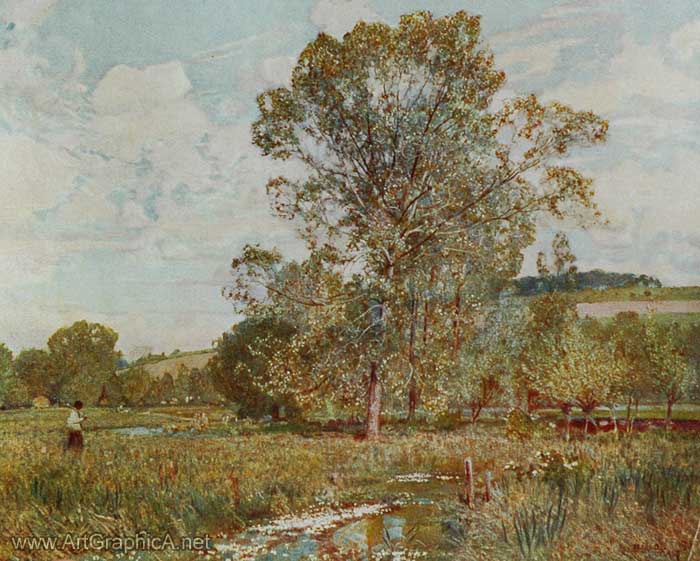 A Berkshire Meadow. Painting Trees. You have already designed your picture as to the quantity, the space, and shape of your trees ; now you have to consider their colour and character. After you have blocked them in with the rest of your landscape, broadly and simply, as the whole " lay in " must be, you may, at the next painting, paint the sub-masses with the rest of your picture ; then next the smaller masses and so on, something like a pile of coins--the first painting broad like a crown, the next over it like a florin, the next like a shilling, a sixpence, and a threepenny-piece. That is how you paint a tree, each painting being a step nearer the realisation of your aim, which must be to paint your tree in exact relation to the landscape in Nature, and on your canvas in exact relation to the rest of the picture. This is essential. 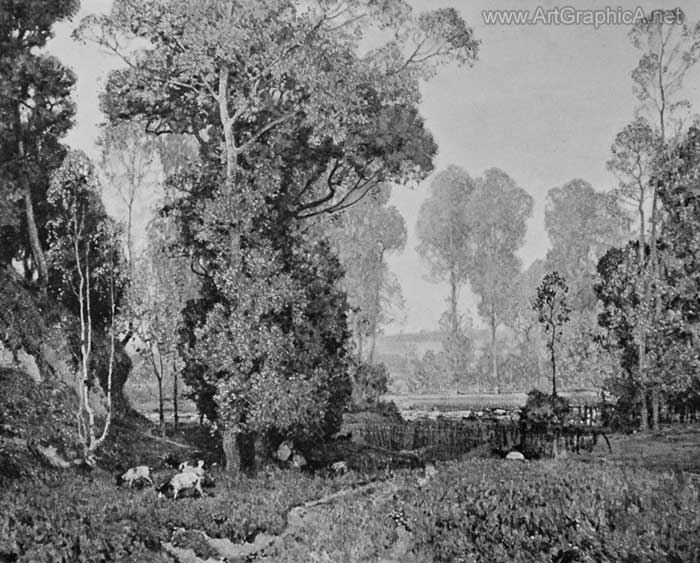 Morning at Montreuil. Painting Trees. 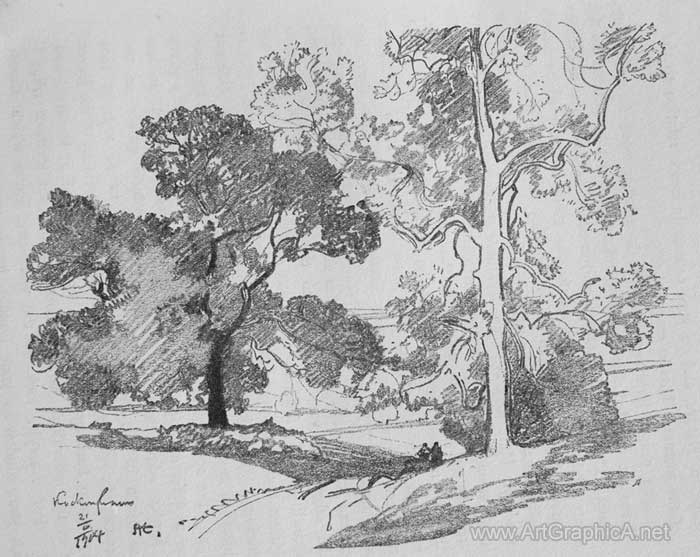
The proper lighting of a tree is another word for modelling. Trees are rounded objects, and therefore must not be painted as flat tones. They are living objects and must be painted so as to express their vitality. That brings me to the point of their edges which come against the sky. In no part do they realise the sense of their vitality so much as where their moving leaves are marked against the sky. Here they are seen, and here their shape and action are most strongly felt. If we look at a photograph, the edges of the trees do not give you the feeling that the tree is a living thing, they are marked with hard precision against the light, like a solid building, and yet at the same time if we see them in Nature we hear the whisper of their leaves and know that they live and breathe. To express that, is a greater truth than the camera can reveal, and a higher form of realism. Of course, the edges will vary according to the species of trees, and also according to the different conditions of effect. For instance, trees against the light appear different to those upon which the light is shining. An oak against the setting sun is a very different object to a birch which is bathed in the full glare of sunshine. Again, the speed of movement of the leaves against the sky gives one a different impression. The elm moves slowly and so has a harder edge than the black poplars, which quiver in the east breath of air, and must be so painted as to suggest that characteristic quality. If the eye follows the movement of the leaves they appear hard against the sky, but if you look at the tree, and not at the individual leaf, you will recognise the truth of what I say. For example, look at the plane-tree leaves which almost touch your window in your London home ; you can mark their shape and colour ; but look at the plane-tree leaves on the opposite side of the street and you can only see the aggregate of their leaves. You know that the aggregate is composed of the same kind of leaves that are near you, and from your knowledge of that fact, you wish to paint them, but you cannot. What of the near ones, if the distant ones were so realised ? You could not paint them more real than life. So remember this great truth, that there is as much beauty in the aggregate of details as in the details themselves. 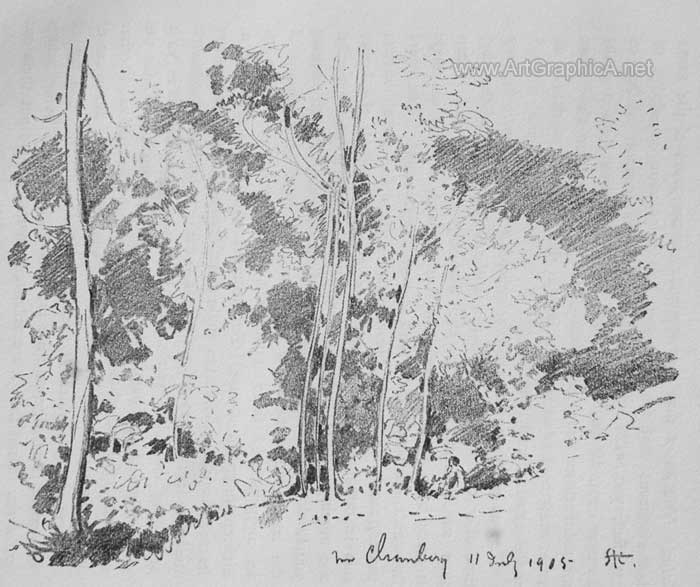
Let us watch the action of a leaf on a black poplar. It may first offer us in its movement a surface which reflects the sky, then as it turns from us, the thin edge is only seen, then it turns back again the reflective surface, and showing an angle by which its actual form and colour are revealed. These are phases, each affording us the reflective surface and the silhouette; this is but one leaf. If we bear in mind that all the leaves are moving more or less, you will come to the conclusion, if you think for a moment, that round the edge of the tree where the leaves are against the sky, the edge must be made up of an aggregate of these movements. They are also turning at different intervals of time. For instance, while one is a silhouette, its neighbour may be at the angle of reflection, and another showing the thin line of its edge where all the intermediate movements are going on. Now you cannot paint actual movement in your picture, but if you paint the edge of a tree which combines the silhouette, the reflection, and the edge of the leaf and other intermediate positions of the leaves, you will obtain the sense of their movement, which is such a desirable quality. The act of movement means life, and life interests us, for we are living beings ourselves. Dead things are abhorrent to us, and we put them out of sight. I remember an eminent painter saying to me, " I see foliage hard against the sky as an edged mass." I answered, " So do. I, but I do not feel it so." You may depend upon it that if you think that the imitation of Nature is the end of landscape painting, then I need not write another line, for no explanation is required, no directions needed. The painter is simply to sit down and paint what he sees ; if he does so, he has probably pleased himself, but he has deceived others. Imitation is not art, and in the imitation of things one loses his own personality, he is a menial, not a creator ; and if he is willing to give up his authority over the created things which were intended for his use, lie cannot have any hope, and there is no faith in him. The slavery of imitation is terrible. If the painter cannot give us something he feels in Nature that others have missed, why paint at all ? There is no place for him. 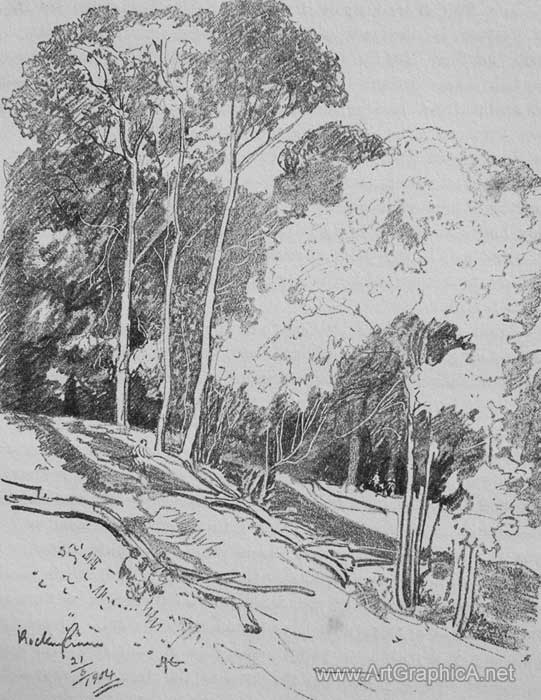
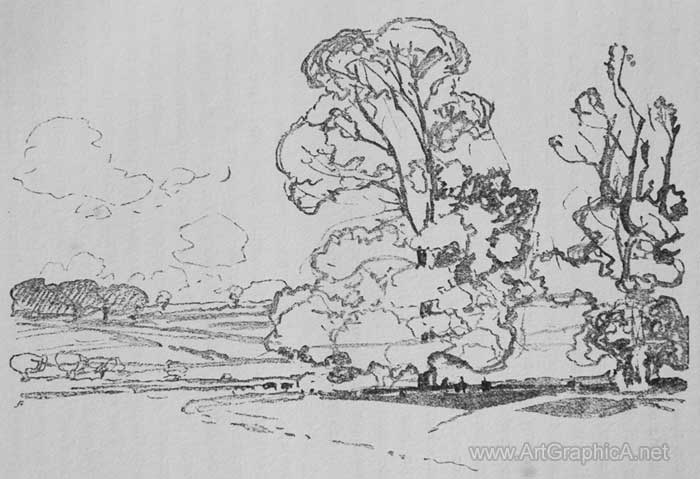 Elm Trees. Note how Corot painted the edges of his trees by the simplest possible means, and Turner by reducing the intensity of his colour. Every painter has his own method, but all have the same end in view. Each must solve the difficult problem in his own way in seeking for the truth. 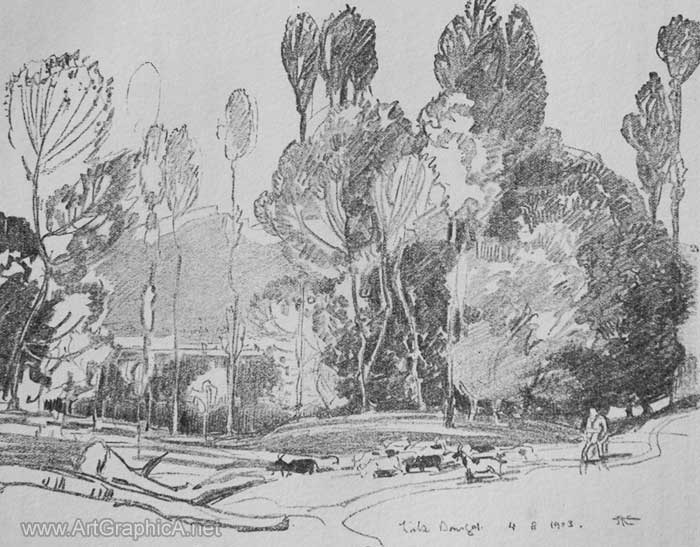
Now let me speak of the " bones " of the trees. See that your trunks and branches are solid things. Strong and hard by contrast, they, too, will help to suggest the movement of the leaves. Now comes the difficulty of the interstices, i.e. the light shining through the trees. See that they do not upset your composition, for the next greatest accent in a landscape to the human figure is the light seen through a tree, for it is generally in proximity to the darkest shadow. The right-angle of a branch and trunk, in the centre of your tree, with the sky beyond, forms a counterpoint in your picture, which, if not justly placed, will completely upset the balance of your composition. It is the most assertive thing in its whole appearance, and if it is necessary to include it to support the characteristic growth of your tree, be careful that it does not spoil your composition. You know that the colour of the sky seen between the interstices of the tree is the same colour as the wide expanse you have in your picture. So it is in Nature; but paint it so, and immediately it will "shout." You must lower the tone, or you will spoil the ensemble of the work by unduly attracting the eye to one particular spot, and so destroy the breadth of your effect. This is another example that the truth in Nature is not always the truth in Art. You must reduce the tone of the open spaces of your branches to give actually of the same colour as the general I say, it is actually some degrees lower. 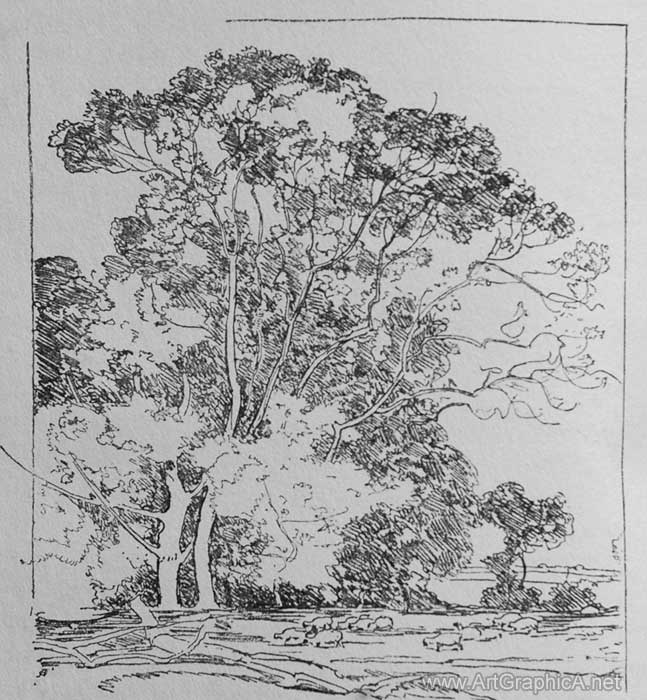 Stow on the Wold. (Soft Ground Etching). One word more. The great advantage of painting your sky to suit your landscape (as described in another chapter) is that you can paint into the sub-tone, covering part and leaving part, and by so doing you advance that feeling of the movement of the leaves against the sky. 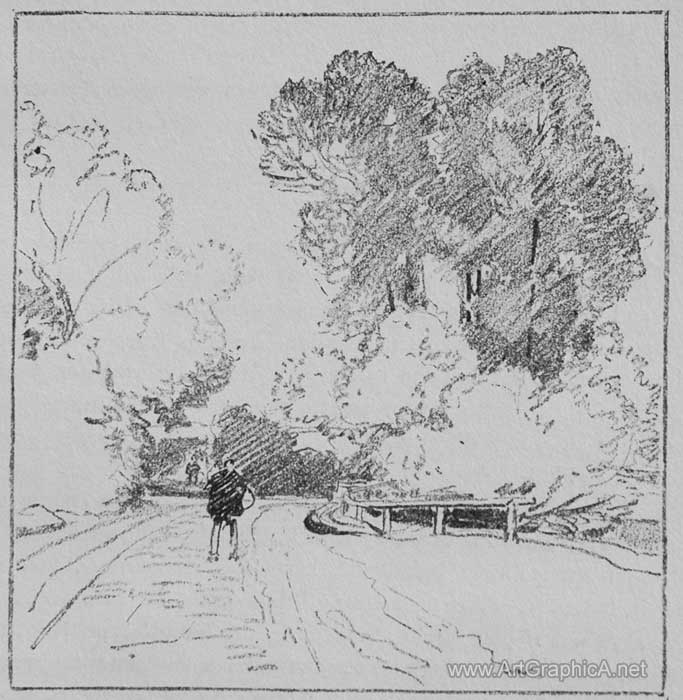 On the Ouse. You must, as I have said before, find out yourself, by careful study and observation, how this is to be done, bearing in mind that the greatest realism is the expression of the vitality and character of the thing painted.
Next Page
Prev PagePainting the Sky What is Colour?
|
|||||||||||||||||||||








